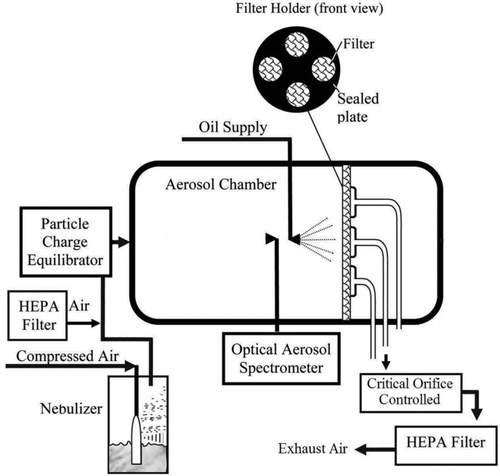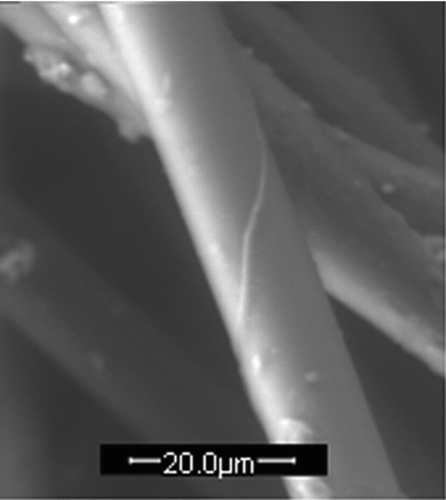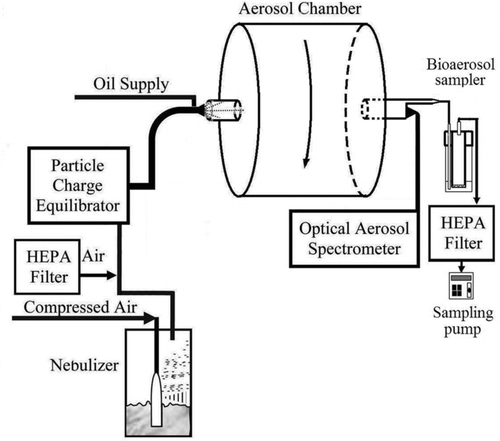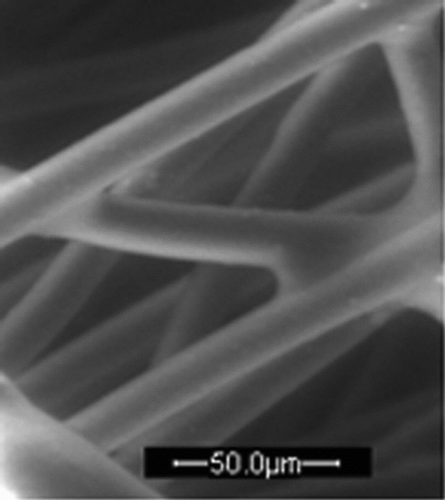Abstract
Our previous studies demonstrated that precoating of filter fibers with biologically active tea tree oil (TTO) enhances physical collection efficiency of conventional heating, ventilation, and air conditioning (HVAC) filters, and provides cost effective and rapid inactivation of captured bacterial and fungal particles on the filter surface. The main aim of this study was to investigate the antiviral activity of two natural disinfectants, i.e., TTO and eucalyptus oil (EUO), against the influenza virus captured onto the filter surface. It was found that both tested oils possess strong antiviral properties when used as fiber coating materials, capable of inactivating captured microorganisms within 5–10 min of contact on the fiber surface. The antiviral activity of TTO was also successfully challenged in aerosol form by mixing viable airborne viral particles with oil droplets in the rotational aerosol chamber. The results look very promising for further development of virus inactivating procedures and technologies for air quality applications.
Copyright 2012 American Association for Aerosol Research
INTRODUCTION
Due to considerable impact on human and animal health, biological aerosols are becoming an increasingly important subject of research investigations all over the world. Removal of microbiological particles from the ambient air with their following inactivation would be one of the most efficient ways to minimize risks of direct exposure to airborne particles or particles re-aerosolized from collecting surfaces. Since filtration remains the most efficient method of the airborne particle removal, it is commonly used for purification of air from microbial particles on its own, or in combination with additional procedures and technological modules enhancing the process efficiency with minimal alteration of the filter hydrodynamics. Such filtration enhancing procedures include utilization of unipolar ions (Huang et al. Citation2008), electrostatic charging of the filter media (Raynor and Chae Citation2004), coating of fibers with liquids (Agranovski and Braddock Citation1998; Boskovic et al. Citation2007), and others.
Considering the fact that collected microbial aerosols remain on the filter surface, some possibility of their following detachment and re-aerosolization back to the gas carrier could not be neglected. The re-aerosolized particles could still be alive causing substantial risks for residents and environment. This issue could be addressed by adding disinfecting agents into the gas carrier or undertaking some inactivation procedures directly on the filter surface, making microbial particles inactive in the cases of potential re-aerosolization.
There are some technological approaches available for microbial disinfection. They include photocatalytic decomposition of microbes on titanium oxide surface irradiated by ultraviolet (UV; Vohra et al. Citation2006; Grinshpun et al. Citation2007), infrared (IR) radiation-based thermal decomposition (Damit et al. Citation2011), using chemicals directly injected into the air carrier or applied onto the filter surface (Pyankov et al. Citation2008; Huang et al. Citation2010), and others. Among variety of various disinfectants, some natural oils look promising due to low or nontoxic nature, especially in diluted form (Carson et al. Citation2006). During the last decade, a variety of essential oils from plants have been screened to assess their antimicrobial activity (Reichling et al. Citation2009).
The potential use of oils, such as tea tree oil (TTO) and eucalyptus oil (EUO), as disinfectants was clearly showed in recent in vitro studies regarding antibacterial (Wilkinson and Cavanagh Citation2005; Carson et al. Citation2006; Salari et al. Citation2006; Hayley and Palombo Citation2009), antifungal (Hammer et al. Citation2000; Oliva et al. Citation2003), and antiviral activities (Schnitzler et al. Citation2001; Cermelli et al. Citation2008; Garozzo et al. Citation2011). In addition, it was shown that essential oils are heterogeneous mixtures, with considerable batch to batch variation of constituents, depending on growth conditions at the plantations (Kawakami et al. Citation1990; Moudachirou et al. Citation1999). The antimicrobial activity of TTO is attributed mainly to terpinen-4-ol (35–45%) and 1,8-cineole (1–6%); however, other components such as a-terpineol, terpinolene, and a- and c-terpinene are also often present and potentially contribute to microbial disinfection (May et al. Citation2000). The EUO from different Eucalyptus species contains 1,8-cineole, a-pinene, and a-terpineol as major common compounds (Jemâa et al. Citation2012). A pharmaceutically graded EUO is commonly enriched up to 70% concentration of 1,8-cineole.
Recently, we suggested a technology based on coating fibrous filters by TTO, and reported the results of feasibility studies on the disinfection of bacteria (Pyankov et al. Citation2008) and fungal spores (Huang et al. Citation2010). In these studies, the TTO was used as both, filter efficiency enhancing media and disinfectant on bacterial and fungal aerosols captured on the filter surface. Considering current strong interest toward influenza related research, the present study is logical continuation of our previous investigations with the focus on the assessment of antiviral activity of essential oils (TTO and EUO) on inactivation of airborne influenza virus.
MATERIALS AND METHODS
Cells and Virus
The Madin–Darby canine kidney (MDCK) cells, from the American Type Culture Collection (Bethesda, MD), were kept in a humidified 5% carbon dioxide atmosphere at 37°C, and grown in Dulbecco's Modified Eagle Medium (DMEM) High Glucose 1× medium (GIBCO, Grand Island, NY, USA) supplemented with 15 mM Hepes (pH 7.4), 10% heat-inactivated fetal calf serum (FCS), 2 mM l-glutamine, 1 mM sodium pyruvate, 100 U/mL of penicillin, and 100 μg/mL of streptomycin.
Influenza virus A strain NWS/G70C (H11N9) (Air et al. Citation1987) was obtained from Commonwealth Scientific and Industrial Research Organization (Melbourne, Australia), and was propagated in MDCK cells in virus maintenance medium composed of DMEM containing 15 mM Hepes (pH 7.4), 2 mM l-glutamine, 1 mM sodium pyruvate, 100 U/mL of penicillin, 100 μg/mL of streptomycin, and 1 μg/mL of tolylsulfonyl phenylalanyl chloromethyl ketone (TPCK)-treated trypsin (Worthington Biochemical, Freehold, NJ, USA).
To prepare viral suspension for aerosolization, the MDCK cells infection was performed with virus at a multiplicity of infection of 0.05 per cell. After 1-h of adsorption at 37°C, the cells were washed twice with phosphate-buffered saline (PBS), placed in medium, and then incubated at 37°C with 5% CO2. Virus was harvested when the cytopathic effect was visually evident, usually 3–4 days after inoculation. The virus working stock solution was prepared as cellular lysate using virus maintenance medium, sonicated 5 min in ultrasound bath, and then centrifuged (5000 × g for 30 min at 4°C) at concentration 5 × 107 plaque-forming unit (PFU)/mL. Final suspension was diluted to 5 × 106 PFU/mL, and placed into a Collison nebulizer (BGI Inc., Waltham, MA, USA) for aerosolization.
Oils
Three types of oil were used in the present study for evaluation of the influenza virus survival rate under influence of potentially disinfecting and biologically inactive material. The TTO and EUO were chosen as potentially active antiviral materials (Schnitzler et al. Citation2001). The light mineral oil (LMO) was chosen as a negative control due to its biologically inactive nature (Cat.: M3516, Sigma Chemicals, MO, USA).
The TTO (Felton Grimwade & Bosisto's Pty. Ltd., Oakleigh South, Australia) is originated from Melaleuca alternifolia strains (native to New South Wales, Australia). The TTO has a multicomponents nature, and it is generally considered to possess a low toxicity (Carson et al. Citation2006), especially in dilute form. Pharmaceutically graded EUO (Felton Grimwade & Bosisto's Pty. Ltd., Oakleigh South, Australia), originated from Eucalyptus polybractea (Blue Mallee), containing more than 70% cineole (eucalyptol), was also used in the experiments. All oils have similar density (0.86–0.91 g/cm3) and viscosity (2.2–4.6 cP), which ensure similar physical behavior when applied onto the filters surface, leaving biological activity solely for comparison of the results.
Experimental Setup and Procedure
Two series of experiments, i.e., inactivation of collected viruses by oils on the filter surface and inactivation of airborne viruses by aerosolized oils were undertaken. The laboratory setup used for the first series is shown in . Four 38 mm diameter filters were installed in parallel in a specially made filter holder and hermetically sealed in the aerosol chamber ensuring no air bypass. A polypropylene fibrous filter with the fiber diameter of 12 μm, thickness of 2 mm, and packing density of 29% was used in this investigation (). Relatively high filtration efficiency was required to maximize the quantity of bioaerosols accumulated on the filter surface during the shortest possible time of the bioaerosol generation equipment operation. Identical quantity of collected material on each filter was achieved by using critical orifice on each filter line controlling the flowrate passing through each filter at the level of 12 L/min. Prior to discharge to the atmosphere, each filter line was equipped with the high-efficiency particulate air (HEPA) filter eliminating any possibility of the airborne virus escape to the laboratory space. Undiluted oils used in particular experiments were delivered onto the filter surface by a Collison nebulizer (BGI Inc., Waltham, MA, USA) over 30 s of the device operation. This time interval was found to be sufficient to ensure efficient and uniform fiber coating, which was visualized by a FEI Quanta 200F Environmental scanning electron microscope (ESEM). The advantage of the ESEM compared to the conventional scanning electron microscope (SEM) is based on its capability to operate at multiple pressure limiting apertures separating the sample chamber from the column, enabling oily nonconductive samples to be examined in their natural state without modification or preparation.
Airborne virus was generated by the collison nebulizer from a liquid suspension with the concentration of around 5 × 106 PFU/mL, prepared according to the procedure described previously. The nebulizer operated at a flow rate of 6 L/min of dry and filtered compressed air. Before the entry into the aerosol chamber (length 30 cm, diameter 12 cm), the virus-containing stream from the nebulizer was mixed with 42 L/min of make-up stream of dry and HEPA-filtered air to maintain a flowrate of 48 L/min, required for the aerosol chamber operation. Aerosol particles were then neutralized to a Boltzmann equilibrium charge distribution using a neutralizer (model 3012, TSI, St. Paul, MN, USA). A total quantity of viral aerosol captured by each filter was monitored by a fluorescent dye (fluorescein sodium salt, C20H10Na2O2, Fluka AG, Buchs, Switzerland) added to the viral suspension in the nebulizer at the concentration of 0.5 mg/mL. It was used as a physical tracer to monitor quantities of virus loading on the filters (Agranovski et al. Citation2006).
The air temperature and humidity were continuously monitored and controlled throughout the entire experimental program (T = 23–25°C and RH = 45–55%). Uniformity of particle concentration and size distribution in the aerosol chamber were continuously monitored throughout each experimental run by a real-time optical aerosol spectrometer (Model 4705, Aeronanotech, Moscow, Russia) to trace any unfavorable variations in aerosol supply.
Three experimental runs were undertaken for each oil used in the present study. The same number of repeats was undertaken for the negative control scenario, when no oil was supplied onto the filter surface prior to the bioaerosol supply. The following procedure was used for all experimental runs. Four filters were installed in the holder and hermetically sealed in the aerosol chamber. Oil supply was provided for 30 s coating all fibers by the films. The viral suspension was then aerosolized by the nebulizer for 2 min time period ensuring sufficient amount of viral material collected on the filter surface. The nebulizer was then shut down and the filter holder removed from the chamber. The first filter was immediately removed from the holder and placed into a vial with 20 mL of DMEM-based virus maintaining medium and sonicated in the sonic bath for 5 min. This step was required to dilute oil from the filter surface, which stops its antiviral action enabling the identification of time-related inactivation efficiency of the oil for any particular time interval. Then, the remaining three filters were removed with 15 min increments, and placed into identical vials containing similar quantities of the virus maintenance medium. This procedure allowed identification of time-related pattern of the oil efficiency on inactivation of viable virus on the filter surface. On completion of the entire experimental run, all vials were placed into a sonic bath for another 5 min to create maximum uniformity of the suspension with following collection of aliquots for determination of virus particles remaining infective.
Infectivity of the virus stock and virus yield in the experiments was determined by a plaque assay technique. Briefly, freshly prepared 24-well plates with 100% confluent of MDCK cells were washed twice with PBS to remove FCS, and then inoculated with 10-fold virus dilutions on virus maintenance medium. After 1 h of adsorption at 37°C, the inoculum was removed; the plates were washed with medium to remove virus suspension and oils, and then overlaid with solid agar medium (virus maintenance medium supplemented with 0.8% agarose). Three days after incubation at 37°C, cells were fixed with 10% formaldehyde solution, then stained with 1% crystal violet dye solution, and thereafter the plaques were counted. The final results were presented in PFU/mL.
The second series of experiments was focused on evaluation of activity of aerosolized TTO against airborne influenza virus in the ambient air. A laboratory setup used for this series of experiments is shown in . A rotational toroid shaped 200 L aluminium aerosol chamber (650 mm diameter and 600 mm long) was designed to keep materials in airborne form over extended periods of time of up to 48 h (Pyankov et al. Citation2012). The optimal rotation speed was found to be around 7 rpm. The axis was designed to be stationary, enabling to host pipelines used for aerosol charging and monitoring. The TTO was used as a disinfectant and natural virus inactivation in the air was used for control purposes (no oil was added to the chamber). The following procedure was used for experiments. First, the chamber was preloaded with oil aerosol for 30 s by the Collison nebulizer. Second, the viral aerosol was aerosolized from the suspension, according to the previously described procedure, and supplied into the chamber over 2 min of the nebulizer operation. Similarly to the previous procedure, the fluorescent dye was used as physical tracer to control viral concentration in the chamber throughout the entire experiment. The aerosol samples were taken by a ``bubbler'' type personal bioaerosol samplers (Agranovski et al. Citation2005) over 1.5 min of sampling time. Sampler's flow rate was 4 L of air per minute. Sampling was undertaken at 5, 15, 30, and 60 min time periods counted from the completion of the virus aerosolization event. Considering that at each sampling point 6 L of air were removed from the chamber (200 L) and replaced with HEPA-filtered air of the same quantity, the following equation was used to correct each particular result:
Aliquots of collecting liquid (virus maintenance medium) from the samplers were taken for virus plaque assay and fluorescence measurements, enabling the identification of microbial decay as a function of time of TTO exposure. All control experiments were undertaken according to the similar procedure with no oil supplied into the chamber. At least three repeats were undertaken for each experimental run.
Considering the fact that biologically active materials are capable to destroy cells used for plaque assay procedure, a series of experiments identifying maximal concentration of TTO and EUO safe for the MDCK cells was undertaken. The procedure was as follows: according to the experimental requirements, the maximum time of direct contact of active oils and MDCK cells was up to 1 h during viral inoculation event. Then, the wells were washed and rinsed removing all extraneous materials including oils from the MDCK surface. Based on this requirement, serial two-fold dilutions of oils in the DMEM viral culture medium were prepared and added into the wells containing monolayer of MDCK cells and left for 1 h. It was found that both TTO and EUO exhibited clear cytopathic effect on MDCK cells at concentrations higher than 0.2% (v/v) in culture medium over 1 h exposure time (data not shown). In contrast, the concentration of LMO in medium did not affect the cells viability over the concentration range of up to 0.5% (v/v).
RESULTS
The photograph of the oil coated filter is shown in . No difference in coating efficiency or film characteristics was observed for all three oils used in this project. As is seen, oil coats fiber uniformly with no uncoated surface observed. This is especially important as it ensures collected viral particle always remaining in the close vicinity to the oil, enhancing inactivation efficiency of the process. The thickness of the film was approximately 4 μm (). The rest of the oil was usually drained from the fibers under action of gravity.
Size distributions of all aerosol particles used in experiments are shown in . As is seen, both TTO and EUO show almost identical trends in size distribution with most of particles ranging between 0.4 and 2.7 μm and the peak diameter at around 1.5 μm. The LMO has a slightly larger peak diameter of approximately 1.8 μm with majority of particles lying between 0.4 and 3.2 μm. A significantly different size distribution was observed for aerosolized virus suspension with the particle peak diameter of about 1 μm. Also, vast majority of particles had sizes below 2.2 μm.
FIG. 5 Particle size distributions of aerosolized oils and virus suspension. Error bars represent standard deviation of at least three experimental runs.
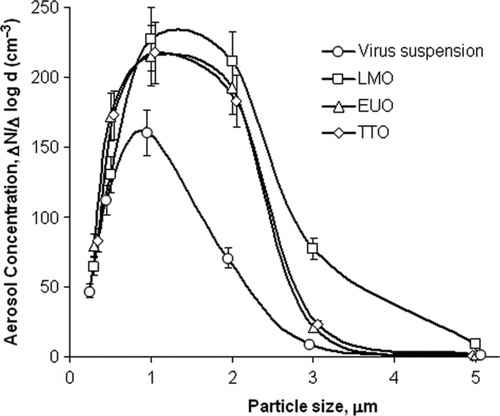
shows the results on the influence of different concentrations of TTO and EUO, directly added to the viral suspension, on the viral plaque formation on the MDCK host cells. The error bars show standard deviations of at least three experimental runs. In these experiments, the LMO was used as a biologically inert material with similar physical properties to the biologically active oils. Some decrease in the number of PFU at concentrations of up to 0.1% (v/v) for TTO and EUO could be observed, however, it was not statistically significant compared to the numbers obtained for lower concentrations of both oils, as was confirmed by a single factor analysis of variance (ANOVA) test (p > 0.05). The lowest concentration causing statistically significant virus inactivation was at the level of 0.2% (v/v). For the biologically inert LMO, statistically significant decrease of the influenza virus plaque formation was not observed over the entire range of concentrations used in this research.
FIG. 6 Inactivation of influenza virus by oils in liquid medium. Error bars represent standard deviation of at least three experimental runs.
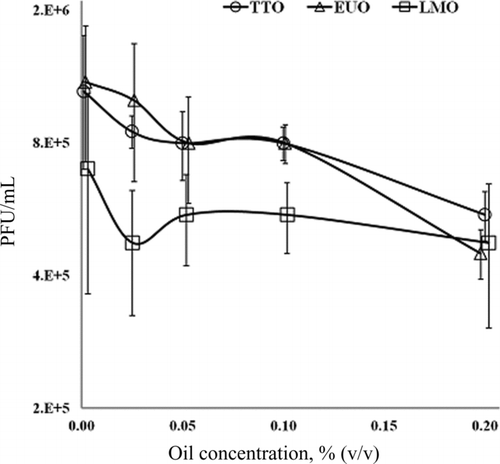
TABLE 1 Reference fluorescence of the material loaded onto the filters. The data cover all experiments with filters
Based on this finding, along with the previously discussed results on the influence of the active oils on the MDCK cells, the amount of the elution medium (DMEM) for the first series of experiments was estimated to be 20 mL enabling to minimize/eliminate any influence of the active oils on the cells and viral materials beyond the required time point. Such estimate was based on the assumption that the total quantity of the oil supplied onto the filter surface should not exceed 0.1% (v/v) concentration after dilution in the elution medium to meet the requirements for both viral materials (0.1%) and MDCK cells (0.2%). It was also found that 5 min of vigorous shaking (using orbital shaker at 250 rpm) with consequent sonication for 5 min in the sonic bath are sufficient to transfer entire amount of viral material and oil from the filter into the bulk of elution medium (data not shown).
The relative fluorescence of the material captured by filters is presented in . Considering that similar quantities of dye were added to similar volumes of the suspension, the discrepancy between readings were not very large, which is reflected by relatively low standard deviations representing all experimental runs used in this project.
TABLE 2 Relative survival of influenza A virus on the filter surface, treated with oils
TABLE 3 Inactivation of airborne influenza virus by aerosolized TTO
The results of the viral inactivation on the filter surface are shown in . All results were corrected according to the reference fluorescence level of the material loading on the filter. The error bars show standard deviation of at least three experimental runs. As is seen, the inactivation of virus on the dry filter and in presence of biologically neutral LMO shows very similar trends. Over the initial 15 min of the experimental run, the viral inactivation in the ambient air reached 40% with following decrease of the number of live virions over the remaining 45 min of the experiment. The final inactivation of viral particles was around 95% over the entire experimental time. Similar trend was observed in the case of the filter treatment by LMO (47% of inactivation for 15 min and 97% for 45 min interval). For both cases, statistically significant inactivation was observed for all time intervals and confirmed by a single factor ANOVA test (p < 0.05). Relative viral survival values were also calculated as a ratio of viable virus concentration on the surface of oil coated filter by the viable virus concentration on the surface of untreated filter for each experimental time point. The results are shown in .
FIG. 7 Inactivation of influenza virus by oils on the filter surface. Error bars represent standard deviation of at least three experimental runs.
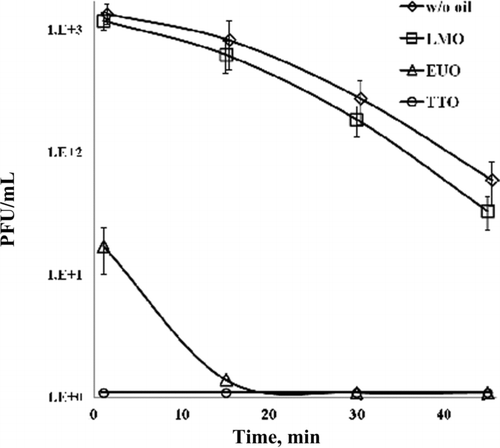
Much more efficient inactivation was observed in cases of active oils treatment. No live particles were observed even at the first time point in the case of the filter treatment by TTO, showing very high efficiency of this material as an antiviral agent. In the case of fiber treatment by EUO, some very low titer of virus was only observed for the first time interval with no evidence of presence on viable particles on the filter surface identified for all remaining experimental points.
The results of the second series of experiments related to antiviral activity of the most effective antiviral oil (TTO) against influenza virus in aerosol form are shown in . Samplers were charged with fresh collecting liquid for each sampling time and operated for 1.5 min at the flowrate of 4 L/min. As is seen from the table, statistically significant inactivation of the airborne influenza virus was identified for all four sampling points. The inactivation was relatively rapid over the first 15 min of run reaching 60%, with following decrease to steady state with around 12% of viral particles remaining viable at the end of the experiment. For the experiment with TTO, the chamber was initially preloaded with TTO aerosol with the concentration of around 0.5 μL per liter of air. Then, virus was aerosolized into the chamber and sampled according to the same protocol and at the same time intervals as for the previous case. The mean results along with the standard deviations of four repeats are also shown in . As is seen, viable virus was detected only at the very first time point with no live particles detected over the remaining experimental points. Some decrease in fluorescence units over time is explained by minor settlement of aerosolized material in the chamber over the experimental run. All virus concentration results presented in the table have been corrected by taking settlement of aerosol into consideration.
DISCUSSION AND CONCLUSION
As was mentioned in the introduction section, essential oils possess a disinfecting activity in vitro against broad range of microbial, fungal, and viral species. Our previous findings on disinfecting activity of the TTO showed effective inactivation of captured fungal and bacterial aerosol on the filter surface (Pyankov et al. Citation2008; Huang et al. Citation2010). Proposed technology of the filter coating with TTO increases the filtering efficiency, and minimizes any risk of re-aerosolization of live bioaerosols back into the ambient air of industrial and residential dwellings. In the present study, the antiviral activity of two essential oils (TTO and EUO) was investigated for viral bioaerosol filtration application. This is the first study of inactivation of live influenza virus on the filter surface.
A range of tested oil concentrations was evaluated for cytotoxic activity on MDCK cells used as a test-system for the influenza virus plaque formation. It was found that both TTO and EUO batches exhibit no cytopathic effect at concentrations of up to 0.2% (v/v). This number is higher compared to the data reported by Garozzo et al. Citation2011, where TTO had no adverse effect on MDCK cell cultures only for the concentrations below 0.025% (v/v). However, Garozzo et al. used much longer exposure time periods (up to few days) at entirely different experimental conditions (no aerosol related experimental runs were undertaken). In addition, the oil composition varies from batch to batch and depends on growth conditions at the plantations (Kawakami et al. Citation1990).
The antiviral activity of aerosolized test compounds were studied in experimental series with virus loaded onto filter surface. At the tested conditions, the use of TTO has revealed complete virus inactivation. As seen from , the virus plaque formation was completely inhibited (even for time 0 point). Comparing to the results of using EUO, the last one showed strong antiviral effect, but with less efficiency. The utilizing LMO did not reveal any antiviral activity, as it has the similar trend of the viral decay with case of absence of any oil. Resuming all above, the two used essential oils possessed strong antiviral activity at the conditions tested. These oils could be successfully used as effective disinfectant in bioaerosol filtration applications.
Additionally, the present study evaluated the antiviral activity of essential oil in aerosol form. Reasonably, the more effective TTO was used in such kind of evaluation. As was found in aerosol form, the TTO possessed the strong antiviral action as well as on the filter surface.
The concentration of aerosolized virus in all experiments was kept at the maximum possible level, which was achieved by relatively high virus titer in the initial suspension prepared for aerosolization (∼107.5/mL). Use of heavily concentrated bioaerosol stream enabled acquisition of more than 103 virions by 1 mL of the collecting liquid (varied slightly in different experiments), which provides opportunities for evaluation of the process efficiency within three orders of magnitude, enabling to identify the inactivation efficiency at the level above 99.5%.
These findings look very promising for the implementation of such aromatic substances in filtration applications to control the harmful bioaerosols, and further improvement of the indoor air quality. Such type of essential oils could be successfully utilized as effective disinfectant against of broad range of microorganisms as well in aerosol form as in form of filter coating substance.
REFERENCES
- Agranovski , I. and Braddock , R. 1998 . Filtration of Mists on Wettable Fibrous Filters . AJChE J , 44 : 2775 – 2783 .
- Agranovski , I. E. , Safatov , A. , Borodulin , A. , Pyankov , O. , Petrishchenko , V. Sergeev , A. 2005 . New Personal Sampler for Viable Airborne Viruses: Feasibility Study . J. Aerosol. Sci. , 36 : 609 – 617 .
- Agranovski , I. , Safatov , A. , Sergeev , A. A. , Pyankov , O. , Petrishchenko , V. Mikheev , M. 2006 . Rapid Detection of Airborne Viruses by Personal Bioaerosol Sampler Combined with the PCR Device . Atmos. Environ. , 40 : 3924 – 3929 .
- Air , G. M. , Webster , R. G. , Colman , P. M. and Laver , W. G. 1987 . Distribution of Sequence Differences in Influenza N9 Neuraminidase of Tern and Whale Viruses and Crystallization of the Whale Neuraminidase Complexed with Antibodies . Virology , 160 : 346 – 354 .
- Boskovic , L. , Agranovski , I. E. and Braddock , R. D. 2007 . Filtration of Nanosized Particles with Different Shape on Oil Coated Fibres . J. Aerosol. Sci. , 38 ( 12 ) : 1220 – 1229 .
- Carson , C. F. , Hammer , K. A. and Riley , T. V. 2006 . Melaleuca alternifolia (Tea Tree) Oil: A Review of Antimicrobial and Other Medicinal Properties . Clin. Microbiol. Rev. , 19 : 50 – 62 .
- Cermelli , C. , Fabio , A. , Fabio , G. and Quaglio , P. 2008 . Effect of Eucalyptus Essential Oil on Respiratory Bacteria and Viruses . Curr. Microbiol. , 56 : 89 – 92 .
- Damit , B. , Lee , C. and Wu , C. Y. 2011 . Flash Infrared Radiation Disinfection of Fibrous Filters Contaminated with Bioaerosols . J. Appl. Microbiol. , 110 ( 4 ) : 1074 – 1084 .
- Garozzo , A. , Timpanaro , R. , Stivala , A. , Bisignano , G. and Castro , A. 2011 . Activity of Melaleuca alternifolia (Tea Tree) Oil on Influenza Virus A/PR/8: Study on the Mechanism of Action . Antiviral Res. , 89 : 83 – 88 .
- Grinshpun , S. A. , Adhikari , A. , Honda , T. , Kim , K. Y. , Toivola , M. Rao , K. S. 2007 . Control of Aerosol Contaminants in Indoor Air: Combining the Particle Concentration Reduction with Microbial Inactivation . Environ. Sci. Technol. , 41 ( 2 ) : 606 – 612 .
- Hammer , K. A. , Carson , C. F. and Riley , T. V. 2000 . Melaleuca alternifolia (Tea Tree) Oil Inhibits Germ Tube Formation by Candida albicans . Med. Mycol. , 38 : 355 – 362 .
- Hayley , L. A. and Palombo , E. A. 2009 . Activity of Essential Oils Against Bacillus subtilis Spores . J. Microbiol. Biotechnol. , 19 ( 12 ) : 1590 – 1595 .
- Huang , R. , Agranovski , I. , Pyankov , O. , Altman , I. and Grinshpun , S. 2008 . Removal of Viable Bioaerosol Particles with a Low-Efficiency HVAC Filter Enhanced by Continuous Emission of Unipolar Air Ions . Indoor Air , 18 : 106 – 112 .
- Huang , R. , Pyankov , O. V. , Yu , B. and Agranovski , I. E. 2010 . Inactivation of Fungal Spores Collected on Fibrous Filters by Melaleuca alternifolia (Tea Tree Oil . Aerosol Sci. Technol. , 44 ( 4 ) : 262 – 268 .
- Jemâa , J. M. B. , Haouel , S. , Bouaziz , M. and Khouja , M. L. 2012 . Seasonal Variations in Chemical Composition and Fumigant Activity of Five Eucalyptus Essential Oils Against Three Moth Pests of Stored Dates in Tunisia . J. Stored Prod. Res. , 48 : 61 – 67 .
- Kawakami , M. , Sachs , R. M. and Shibamoto , T. 1990 . Volatile Constituents of Essential Oils Obtained from Newly Developed Tea Tree (Melaleuca alternifolia) Vlones . J. Agric. Food Chem. , 38 : 1657 – 1661 .
- May , J. , Chan , C. H. , King , A. , Williams , L. and French , G. L . 2000 . Time-Kill Studies of Tea Tree Oils on Clinical Isolates . J. Antimicrob. Chemother. , 45 ( 5 ) : 639 – 643 .
- Moudachirou , M. , Gbenou , J. D. , Chalchat , J. C. , Chabard , J. L. and Lartigue , C. 1999 . Chemical Composition of Essential Oil of Eucalyptus from Benin: Eucalyptus citriodora and E. camaldulensis. Influence of Location, Harvest Time, Storage of Plants and Time of Steam Distillation . J. Essent. Oil Res. , 11 : 109 – 118 .
- Oliva , B. , Piccirilli , E. , Ceddia , T. , Pontier , E. , Aureli , P. and Ferrini , A. M. 2003 . Antimycotic Activity of Melaleuca alternifolia Essential Oil and its Major Components . Lett. Appl. Micobiol. , 37 : 185 – 187 .
- Pyankov , O. V. , Agranovski , I. E. , Huang , R. and Mullins , B. J. 2008 . Removal of Biological Aerosols by Oil Coated Filters . Clean , 36 ( 7 ) : 609 – 614 .
- Pyankov , O. V. , Pyankova , O. and Agranovski , I. E. 2012 . Inactivation of Airborne Influenza Virus in the Ambient Air . J. Aerosol. Sci. , 53 : 21 – 28 .
- Raynor , P. C. and Chae , S. J. 2004 . The Long-Term Performance of Electrically Charged Filters in a Ventillation System . J. Occup. Environ. Hyg. , 1 ( 7 ) : 463 – 471 .
- Reichling , J. , Schnitzler , P. , Suschke , U. and Saller , R. 2009 . Essential Oils of Aromatic Plants with Antibacterial, Antifungal, Antiviral, and Cytotoxic Properties—An Overview . Forsch Komplementmed. , 16 : 79 – 90 .
- Salari , M. H. , Amine , G. , Shirazi , M. H. , Hafezi , R. and Mohammadypour , M. 2006 . Antibacterial Effects of Eucalyptus globulus Leaf Extract on Pathogenic Bacteria Isolated from Specimens of Patients with Respiratory Tract Disorders . Clin. Microbiol. Infect. , 12 : 194 – 196 .
- Schnitzler , P , Schön , K and Reichling , J. 2001 . Antiviral Activity of Australian Tea Tree Oil and Eucalyptus Oil Against Herpes Simplex virus in Cell Culture . Pharmazie , 56 ( 4 ) : 343 – 347 .
- Vohra , A. , Goswami , D. Y. , Deshpande , D. A. and Block , S. S. 2006 . Enhanced Photocatalytic Disinfection of Indoor Air . Appl. Catal. B: Environ. , 64 ( 1–2 ) : 57 – 65 .
- Wilkinson , J. M. and Cavanagh , H. M. 2005 . Antibacterial Activity of Essential Oils from Australian Native Plants . Phytother. Res. , 19 : 643 – 646 .
